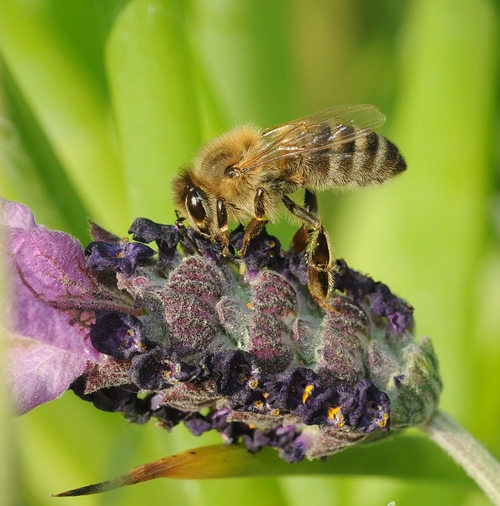- Author: Kathy Keatley Garvey
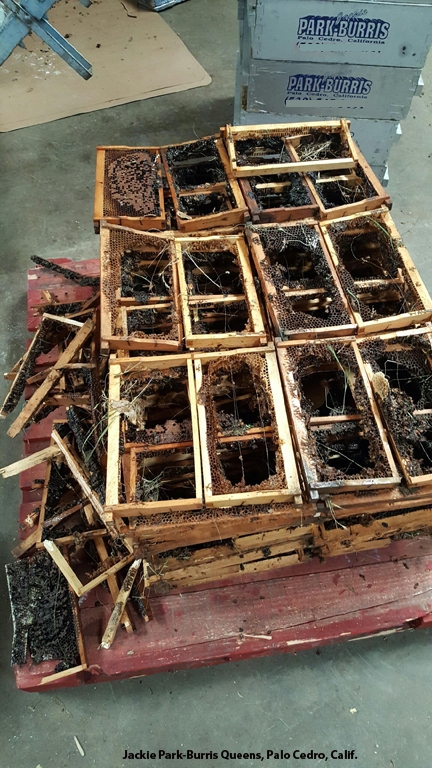
But it's primarily for the bee brood, not the honey.
The brood provides the protein, and the honey, the carbohydrates. For beekeepers and commercial queen bee breeders, this can wreak havoc. Financial havoc.
The American Beekeeping Federation, headed by Gene Brandi of Los Gatos, recently asked Extension apiculturist emeritus Eric Mussen of the UC Davis Department of Entomology and Nematology to respond to a question about bees and bears.
Mussen, who retired in 2014 after 38 years of service (but he still remains active from his office in Briggs Hall), is from Minnesota, where the bears are and he isn't. He's managed to photograph a few bears, though, on family outings to Lake Tahoe.
We thought we'd share his response about bees and bears. Jackie Park-Burris of Palo Cedro, who owns Jackie Park-Burris Queens, kindly let us post some of her photos so our readers can see what bear damage looks like. A past president of the California State Apiary Board and the California State Beekeepers' Association, she's a member of the noted Homer Park beekeeping family and has been involved with bees all of her life. She's been breeding Park Italian queens since 1994.
But back to Eric Mussen, the bee guru who has answered tons of questions during his 38-year academic career and who's now serving his sixth term as president of the Western Apicultural Society. (The society, founded in Davis, will gather \Sept. 5-8 in Davis for its 40th annual meeting, returning to its roots.)
"Bears eat both meat and plants (berries) etc. whenever they can find them," Mussen says. "Most people think that a bear has a sweet tooth, since it is attracted to beehives. While it is true that bears will eat some honey if it gains access to a hive, a closer look shows that it will eat all of what we call 'brood' first, and then eats a little honey."

"Bears have a pretty good sense of smell, so they can smell a beehive if they get downwind of a nearby colony," Mussen points out. "If the colony is living in a tree, often the bear literally tears the tree apart to get to the bees. Unfortunately, they will claw and dig into a man-made beehive, as well. They leave the covers scattered all over; the hive boxes scattered and often broken; the combs pulled out, broken, and strewn about in the apiary; and the combs that had brood in them will have the comb eaten out. The colony will not survive and there may be very little undamaged equipment to salvage."
"To a small-scale beekeeper," Mussen says, "the financial loss is not too severe. However, losing the colony, that requires so much effort to keep healthy these days, is quite a blow. For commercial operators, who may not revisit the apiary for a couple weeks, it can mean a very substantial economic loss."
"The correct type of well-maintained bear fence usually is very effective at keeping bears away from the hives. However, that holds true only for situations in which the bear has not had previous positive experiences ripping apart man-made beehives. In that case, the bear expects a substantial reward for barging through the stinging fence and getting into the hives."
What to do? "Most beekeepers have no desire to kill bears, but they do desire to keep their colonies alive," Mussen says. "Often, attempts are made to capture the offending bear, tag it, and move it away far enough that it should not return. Some of the wildlife specialists marvel in how far away a bear can be taken away and still return. Bears that cannot stay away from apiaries, or away from people's houses, or away from trash containers, etc., sometimes have to be eliminated. It is best to have this done by agency personnel, but sometimes in remote areas the beekeepers get deprivation permits and kill the bear themselves. In Northern California, the beekeeper has to notify the wildlife people of the kill, and the carcass has to be inspected to be certain that specific, black market body parts have not been removed from the bear. The carcass then is buried in a landfill, or once in a while used in institutional food."
Occasionally Bug Squad hears of bears raiding honey bee hives in rural Solano County. We remember a story about a beekeeper/queen breeder in Mix Canyon, Vacaville, who was losing his hives to a "wild animal." The loss? Reportedly about $30,000. He set up a stealth camera and....photographed a 300-pound black bear.
"Bears have a pretty good sense of smell," as Mussen says, and the result can be "a very substantial economic loss."
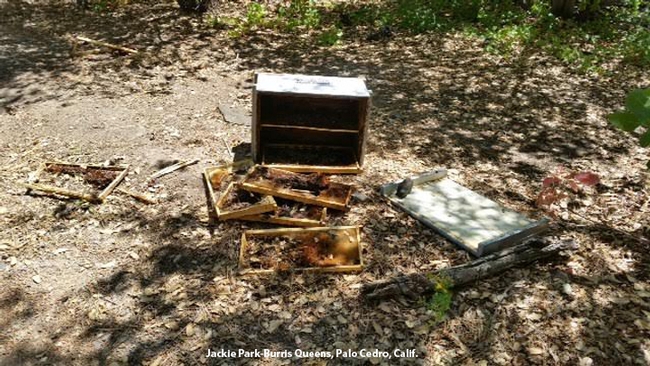
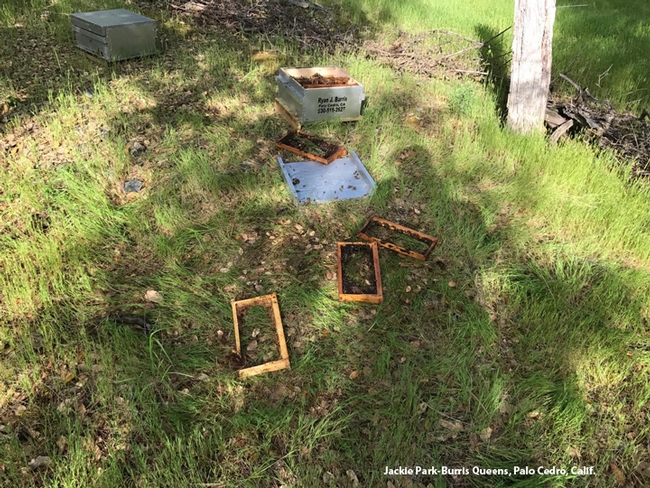
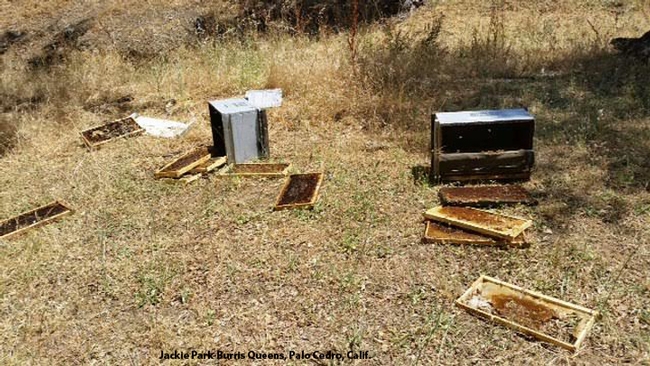
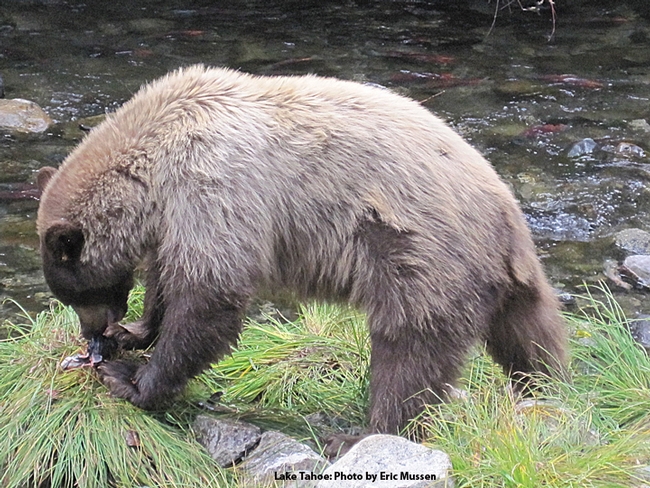
- Author: Kathy Keatley Garvey
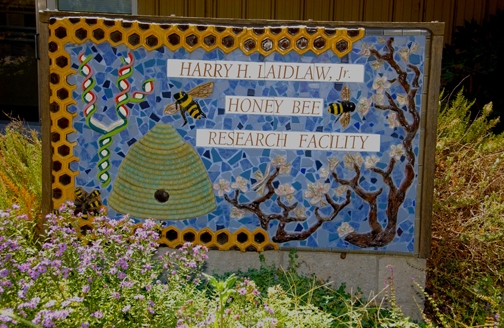
Bee scientists at the Harry H. Laidlaw Jr. Honey Bee Research Facility at the University of California, Davis, are offering a total of four short courses from Feb. 13 to March 20. All will be at the Laidlaw facility, located on Bee Biology Road, west of the central campus. They will be comprised of lectures in the conference room and hands-on exercises in the apiary.
Instructors are Extension apiculturist Elina Lastro Niño; staff research associate Bernardo Niño; facility manager/staff research associate Charley Nye; and graduate student Tricia Bohls.
The first short course, "Planning Ahead for Your First Hives," is set Saturday, Feb. 13. "This is perfect for those who have little or no beekeeping experience and would like to obtain more knowledge and practical skills to move on to the next step of owning and caring for bees," says Elina Niño. You'll learn about honey bee biology, beekeeping equipment, how to start your colony, and maladies of the hive. You'll be shown how to install a package, how to inspect your hive and how to monitor for those dreaded varroa mites. The $95 registration fee covers the cost of course materials (including a hive tool), lunch, and refreshments
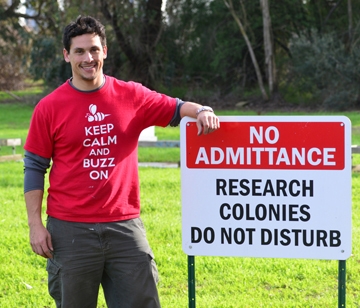
Next will be the "Queen Rearing Techniques" short course. Due to popular demand, there will be two sessions and you can select the one on Saturday and Sunday, March 12-13 or the one the following weekend, on Saturday and Sunday, March 19-20. You'll learn about honey bee queen biology, basics of selective honey bee breeding programs, various queen-rearing techniques, testing hygienic behavior, and assessing varroa mite levels. You'll have the opportunity to learn about and practice multiple methods for queen rearing.
“We will go through a step-by-step process for queen rearing via grafting, including setting up cell builders and mating nucs,” Elina Niño said. At the end of the course, you'll be able to check your grafting success. If you live in the area, you can take home queen cells from the workshop. You'll also learn techniques to assess varroa mite loads and to evaluate hygienic behavior. Each session also will include a guided tour of the adjacent Häagen-Dazs Honey Bee Haven, a half-acre bee friendly garden that attracts many pollinators and is filled with art from the UC Davis Art/Science Fusion Program and entomology/art classes taught by Diane Ullman and Donna Billick.
The $350 registration fee for each queen-rearing session covers the cost of course materials (including a set of grafting equipment: grafting frame with bars, plastic queen cups and a grafting tool), breakfast, lunch and refreshments on the days of the short course.
Interested? For more information, contact Bernardo Niño at elninobeelab@gmail.com or call (530) 380-BUZZ (2899). The Niño lab website is at http://elninobeelab.ucdavis.edu/, and the Facebook page at https://www.facebook.com/elninolab/. The bi-monthly apiculture newsletter, written by Elina Niño, is online.
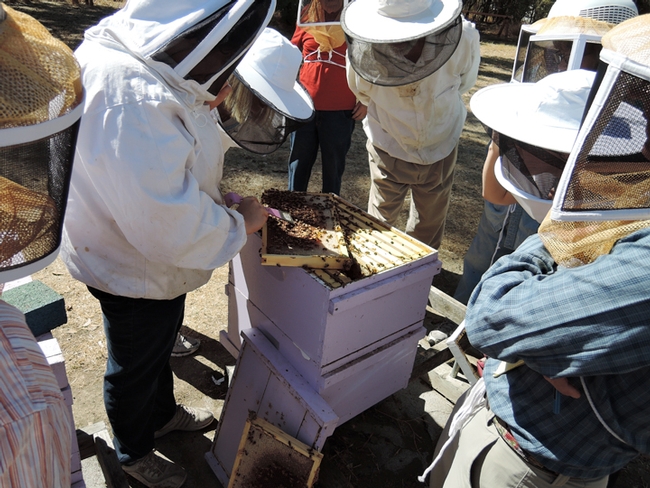

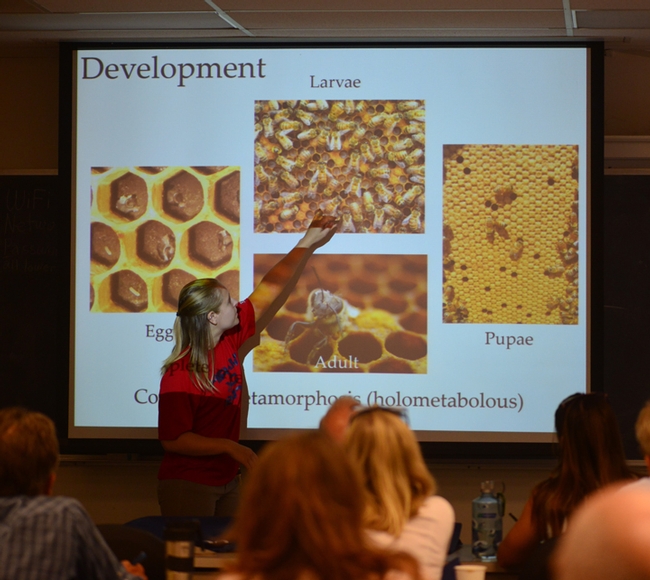
- Author: Kathy Keatley Garvey
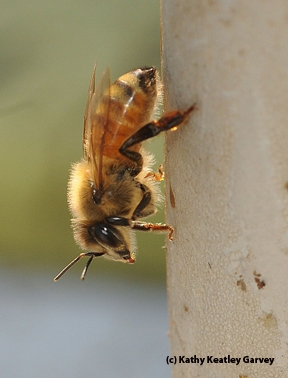
Bystanders panic. Bees can and do react to all the commotion by stinging the first responders and the bystanders. It's especially difficult at night.
So when Extension apiculturist (emeritus) Eric Mussen of the UC Davis Department of Entomology and Nematology, who retired in June 2014 after 38 years of service, was asked about this, and what first responders can do, we thought we'd share the informatoin.
"It is hard to know where to start with protecting people from bee spills," he says. "Depending upon in what part of the country it happens, the concern about loose bees varies. In a large metropolitan area, it is likely that someone will try to put down (kill) the bees as quickly as possible. In rural agricultural areas, the people value the bees and probably would try to salvage as many hives and bees as possible."
"Every potentially responsible agency should have a list of beekeepers to contact when such an incident happens. The beekeepers can go to the scene, access the problem, and help clean it up."

"Water misted into the flying bees will tend to 'ground' them, temporarily, and many will drown," he warns. "To be sure the bees are down for good, some use fire-fighting foam instead of water. This will cause an enormous financial loss for the beekeeper, but it calms things down rather quickly. If the bees form a gigantic cluster under an overpass, the bees can be salvaged or, in at least one case, burned up using a flame thrower."
"People should understand that it takes quite a while to upright the hives and get the frames back into them," Mussen says. "They should also know that the bees are not likely to go back into the hives, on their own, until nighttime." Bees do not fly at night.
"If the bees are being 'rescued,' someone has to help haul away the up-righted hives and put them in a safe place," Mussen points out. "Not infrequently the assisting, anonymous beekeepers leave with the hives and never return them to the owner. Some empty hives have to be left at the scene to collect the remaining bees that are flying around. They can be picked up early the next morning."
Those are just some considerations, Mussen says. "Every event is different. If the emergency folks have met with a few beekeepers to talk about what to do, it will go a lot easier if it ever happens."
Good advice.
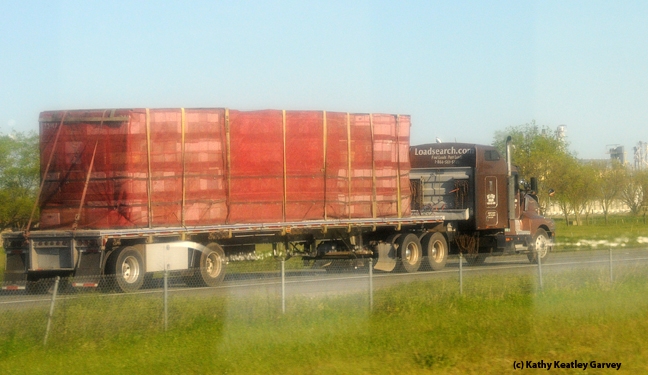
- Author: Kathy Keatley Garvey
St. Patrick's Day is the "wearing of the green," but it's also the "wearing of the yellow."
Wild mustard, that is.
If you drive through the hills of Napa, around St. Patrick's Day, or from January through March, you'll see bee hives nestled in the green landscape with a flourish of mustard (Brassica spp.).
It's a child's delight, a photographer's dream, and a painter's inspiration. But mustard is also a good cover crop and bee food.
Indeed, honey bees crave mustard just like folks on "Irish Day" crave corned bee and cabbage (with that yellow condiment made from mustard seeds).


- Author: Kathy Keatley Garvey
If you built it (a field of dreams), they will come.
And if you bring flowers, that's all the bettter.
Melissa "Missy" Borel, program manager of the California Center for Urban Horticulture, UC Davis, and a strong proponent of bee friendly plants, brought salvia, lavender (Otto Quast Spanish lavender) and some stalked bulbine (Bulbine frutescens) to a television interview today at the Harry H. Laidlaw Jr. Honey Bee Research Facility at UC Davis.
Darsha Philips and camerman Andrew Faulk of Fox 40, Sacramento were there to interview her along with Lynn Kimsey, professor and chair of the UC Davis Department of Entomology and director of the Bohart Museum of Entomology; and Cooperative Extension apiculturist Eric Mussen, a 32-year member of the UC Davis Department of Entomology faculty..
Missy Borel placed the three potted plants atop a hive while waiting for the interview. It didn't take long for the honey bees to find the unexpected treat! They lavished the lavender, salivated over the salvia, and stalked the stalked bulbine.
Meanwhile, concern about the declining honey bee population continues. A third of the food we eat is pollinated by bees. Bee nutrition has never been so important. The bees are seeking nectar, pollen and water to bring back to their hives.
Want to select bee friendly plants for your garden? Missy Borel compiled this list during the Haagen-Daz Honey Bee Haven Design Competition. (See pages 7, 8 and 9 of the PDF). See more information on the winning design on the UC Davis Entomology Web site. The new garden will be located next to all the hives at the Laidlaw facility.
When the half-acre bee haven is completed, the bees won't have far to go to gather nectar and pollen all year around. Look for the dedication sometime in October.

